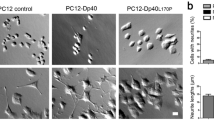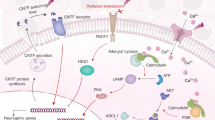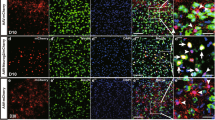Abstract
E2Fs play a central role in cell proliferation and growth arrest through their ability to regulate genes involved in cell cycle progression, arrest and apoptosis. Recent studies further indicate that this family of transcriptional regulators participate in cell fate/differentiation events. They are thus likely to have a prominent role in controlling the terminal differentiation process and its irreversibility. Here we have specifically examined the role of E2F2 in neuronal differentiation using a gain-of-function approach. Endogenous E2F2 increased in PC12 cells in response to nerve growth factor (NGF) and was also expressed in cerebellar granule neurons undergoing terminal differentiation. While PC12 cells normally undergo reversible dedifferentiation and cell cycle re-entry upon NGF removal, forced expression of E2F2 inhibited these events and induced apoptosis. Thus, E2F2 converted PC12-derived neurons from a reversible to a ‘terminally’ differentiated, NGF-dependent state, analogous to postmitotic sympathetic neurons. This contrasts with the effects of E2F4, which enhances the differentiation state of PC12 cells without affecting cell cycle parameters or survival. These results indicate that E2F2 may have a unique role in maintaining the postmitotic state of terminally differentiated neurons, and may participate in apoptosis in neurons attempting to re-enter the cell cycle. It may also be potentially useful in promoting the terminally arrested/differentiated state of tumor cells.
This is a preview of subscription content, access via your institution
Access options
Subscribe to this journal
Receive 50 print issues and online access
269,00 € per year
only 5,38 € per issue
Buy this article
- Purchase on SpringerLink
- Instant access to full article PDF
Prices may be subject to local taxes which are calculated during checkout





Similar content being viewed by others
References
Beijersbergen RL, Carlée L, Kerkhoven RM, Bernards R . 1995 Genes Dev. 9: 1340–1353
Brewer GJ . 1995 J. Neurosci. Res. 42: 674–683
Brook A, Xie JE, Du W, Dyson N . 1996 EMBO J. 15: 3676–3683
Buchkovich KJ, Ziff EB . 1994 Mol. Biol. Cell 5: 1225–1241
Callaghan DA, Dong L, Callaghan SM, Hou YX, Dagnino L, Slack RS . 1999 Dev. Biol. 207: 257–270
Cambray-Deakin MA . 1995 Neural Cell Culture: A Practical Approach. Cohen J and Wilkin GP (eds) Oxford University Press: New York pp. 3–13
Cartwright P, Muller H, Wagener C, Holm K, Helin K . 1998 Oncogene 17: 611–623
Cowley S, Paterson H, Kemp P, Marshall CJ . 1994 Cell 77: 841–852
Cui H, Bulleit RF . 1998 Brain Res. Dev. Brain Res. 106: 129–135
Dimri GP, Itahana K, Acosta M, Campisi J . 2000 Mol. Cell. Biol. 20: 273–285
Dirks PB, Rutka JT, Hubbard SL, Mondal S, Hamel PA . 1998 Oncogene 17: 867–876
Evan G, Littlewood T . 1998 Science 281: 1317–1322
Field SJ, Tsai F-Y, Kuo F, Zubiaga AM, Kaelin Jr WG, Livingston DM, Orkin SH, Greenberg ME . 1996 Cell 85: 549–561
Flemington EK, Speck SH, Kaelin Jr WG . 1993 Proc. Natl. Acad. Sci. USA 90: 6914–6918
Frade JM . 2000 J. Cell. Sci. 113: 1139–1148
Francesconi CM, Hutcheon AE, Chung EH, Dalbone AC, Joyce NC, Zieske JD . 2000 Invest Ophthalmol Vis Sci. 41: 1054–1062
Gaubatz S, Wood JG, Livingston DM . 1998 Proc. Natl. Acad. Sci. USA 95: 9190–9195
Gill RM, Hamel PA . 2000 J. Cell. Biol. 148: 1187–1201
Giovanni A, Keramaris E, Morris EJ, Hou ST, O'Hare M, Dyson N, Robertson GS, Slack RS, Park DS . 2000 J. Biol. Chem. 275: 11553–11560
Gollapudi L, Oblinger MM . 1999 J. Neurosci. Res. 56: 99–108
Greene LA, Tischler AS . 1976 Proc. Natl. Acad. Sci. USA 73: 2424–2428
Hansen LA, Sigman CC, Andreola F, Ross SA, Kelloff GJ, De Luca LM . 2000 Carcinogenesis 21: 1271–1279
Heibein JA, Barry M, Motyka B, Bleackley RC . 1999 J. Immunol. 163: 4683–4693
Kadonaga JT, Carner KR, Masiarz FR, Tjian R . 1987 Cell 51: 1079–1090
Kastner A, Espanel X, Brun G . 1998 Cell. Growth Differ. 9: 857–867
Kowalik TF, DeGregori J, Schwarz JK, Nevins JR . 1995 J. Virol. 69: 2491–2500
Lindeman GJ, Gaubatz S, Livingston DM, Ginsberg D . 1997 Proc. Natl. Acad. Sci. USA 94: 5095–5100
Lukas J, Petersen BO, Holm K, Bartek J, Helin K . 1996 Mol. Cell. Biol. 16: 1047–1057
MacManus JP, Koch CJ, Jian M, Walker T, Zurakowski B . 1999 Neuroreport 10: 2711–2714
Magae J, Wu C-L, Illenye S, Harlow E, Heintz NH . 1996 J. Cell. Sci. 109: 1717–1726
Mesner PW, Winters TR, Green SH . 1992 J. Cell. Biol. 119: 1669–1680
Muller H, Helin K . 2000 Biochim. Biophys. Acta. 1470: M1–M12
Myster DL, Bonnette PC, Duronio RJ . 2000 Development 127: 3249–3261
Nagy Z . 1999 J. Neural. Transm. Suppl. 57: 233–245
Nevins JR . 1998 Cell. Growth Differ. 9: 585–593
O'Hare MJ, Hou ST, Morris EJ, Cregan SP, Xu Q, Slack RS, Park DS . 2000 J. Biol. Chem. 275: 25358–25364
Okano HJ, Pfaff DW, Gibbis RB . 1993 J. Neurosci. 13: 2930–2938
Park DS, Morris EJ, Bremner R, Keramaris E, Padmanabhan J, Rosenbaum M, Shelanski ML, Geller HM, Greene LA . 2000 J. Neurosci. 20: 3104–3114
Persengiev SP, Kondova II, Kilpatrick DL . 1999 Mol. Cell. Biol. 19: 6048–6056
Persengiev SP, Kyurkchiev S . 1993 Int. J. Biochem. 25: 441–444
Raina AK, Zhu X, Rottkamp CA, Monteiro M, Takeda A, Smith MA . 2000 J. Neurosci. Res. 61: 128–133
Ross ME . 1996 Trends Neurosci. 19: 62–68
Slack RS, El-Bizri H, Wong J, Belliveau DJ, Miller FD . 1998 J. Cell. Biol. 140: 1497–1509
Suzuki A, Hemmati-Brivanlou A . 2000 Molecular Cell. 5: 217–229
Takahashi Y, Rayman JB, Dynlacht BD . 2000 Genes Dev. 14: 804–816
Trimarchi JM, Fairchild B, Verona R, Moberg K, Andon N, Lees JA . 1998 Proc. Natl. Acad. Sci. USA 95: 2850–2855
van Grunsven LA, Thomas A, Urdiales JL, Machenaud S, Choler P, Durand I, Rudkin BB . 1996 Oncogene 12: 855–862
Verona R, Moberg K, Estes S, Starz M, Vernon JP, Lees JA . 1997 Mol. Cell. Biol. 17: 7268–7282
Weintraub SJ, Chow KNB, Luo RX, Zhang SH, He S, Dean DC . 1995 Nature 375: 812–815
Yamasaki L, Jacks T, Bronson R, Goillot E, Harlow E, Dyson NJ . 1996 Cell. 85: 537–548
Yan G-Z, Ziff EB . 1995 J. Neurosci. 15: 6200–6212
Zhang HS, Postigo AA, Dean DC . 1999 Cell. 97: 53–61
Acknowledgements
This work was made possible by PHS grants DK36468 and CA-79999 as well as an Annual Research Award from the Worcester Foundation for Biomedical Research to DL Kilpatrick.
Author information
Authors and Affiliations
Corresponding author
Rights and permissions
About this article
Cite this article
Persengiev, S., Li, J., Poulin, M. et al. E2F2 converts reversibly differentiated PC12 cells to an irreversible, neurotrophin-dependent state. Oncogene 20, 5124–5131 (2001). https://doi.org/10.1038/sj.onc.1204663
Received:
Revised:
Accepted:
Published:
Issue Date:
DOI: https://doi.org/10.1038/sj.onc.1204663
Keywords
This article is cited by
-
NGF activation of TrkA decreases N-myc expression via MAPK path leading to a decrease in neuroblastoma cell number
Oncogene (2004)
-
Effect of thyroid hormone responsive protein (THRP) expression on PC12 cell survival
Experimental Brain Research (2003)



